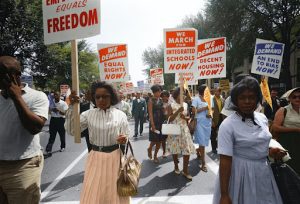Redlining is a form of discriminatory practice in which services—usually financial services, such as mortgages and insurance—are withheld from people who live in neighborhoods with a high proportion of racial and ethnic minorities. These services are denied based on the alleged riskiness of the geographical area, rather than because of individual applicants’ qualifications or creditworthiness.
Since it denies services to entire neighborhoods, redlining perpetuates disinvestment and hinders the economic development of entire communities. As a form of structural racism, redlining can be particularly subtle and difficult to prove, but the legacy of redlining is serious and long-lasting: its effects can be seen for generations, contributing to wealth disparities, racial segregation, and limited access to resources like quality housing, education, and healthcare.
People in redlined communities are typically denied property insurance coverage, charged higher premiums, or offered inferior policies based on their geographic location. The difficulty of finding good, affordable insurance coverage in a redlined area can lead to difficulty obtaining mortgages or maintaining properties, ultimately contributing to urban decay, economic stagnation, and rapid decline in the area’s housing market.
How Did Redlining Start?
While today the process of redlining usually refers to any race-based segregation and discrimination tactics in real estate and property insurance, the specific term “redlining” had its origins in government homeownership programs that were created as part of the New Deal during the Great Depression.
With the passage of the National Housing Act of 1934 and the simultaneous establishment of the Federal Housing Administration (FHA), the federal government began to develop the first nation-wide underwriting criteria for mortgage lending as financial institutions were refinancing mortgages in default to prevent foreclosures.
In 1935, the Home Owners’ Loan Corporation (HOLC) created a series of “residential security maps” for over 200 cities across the country. These HOLC maps designated neighborhoods as either Type A, B, C, or D depending on how desirable they were considered for lending purposes.
The word “redlining” refers to the actual color-coded red patches that were used to indicate which neighborhoods were considered “Type D,” the most high-risk areas for home loans. Areas in red—often urban areas with majority black populations—were deemed the biggest risks, and therefore, homebuyers within them were consistently denied home loans, charged higher interest rates, and denied services.
Redlining wasn’t just an informal practice but a deliberate system of mapping inequality, reinforcing racial segregation and economic divisions through government-backed redlining maps. By using these maps to determine lending risks, federal policy effectively codified discrimination, ensuring that predominantly black neighborhoods faced chronic disinvestment. This practice directly impacted property values, as homes in redlined areas depreciated due to a lack of financing opportunities, while white neighborhoods saw steady appreciation.
Redlining also intersected with exclusionary zoning laws, which restricted where people could live and further entrenched racial segregation. As a result, generations of borrowers from racial groups in redlined communities were systematically denied the wealth-building opportunities that homeownership provided elsewhere.
How Redlining Affects Insurance
While redlining originally referred specifically to the practice of denying home loans in non-white neighborhoods, loans are just one of many financial products that were consistently harder to access in areas deemed “high risk” based on the race of the residents. Property insurance—even car insurance—is another.
Consider an example from the life of Thurgood Marshall, the man who would go on to become the first African-American Supreme Court Justice. In 1940, while he was living in Harlem, he was denied car insurance on the grounds that the neighborhood was “a congested area.” Reflecting on this experience later in life, Marshall noted that this form of discrimination was “‘practically impossible to work out in a court case because the insurance is usually refused on some technical ground.’” ¹
The financial structure of the insurance industry has often favored practices that discouraged insuring predominantly black neighborhoods. Even before the protests and urban riots of the 1960s, adequate insurance was scarce in these areas. This issue extended to reinsurance, as companies struggled to obtain it for urban areas at reasonable prices.
While explicit redlining became illegal under the Fair Housing Act of 1968 and the Community Reinvestment Act of 1977, discriminatory practices still persist in more subtle ways. Insurers may use factors like credit scores, crime rates, or historical loss data as proxies for race or socioeconomic status, leading to similarly exclusionary outcomes.
How Did People Protest Against Housing Discrimination?
Protests against redlining reached a pivotal moment in the late 1960s, particularly through the efforts of Dr. Martin Luther King Jr. in Chicago and the eventual passage of the Fair Housing Act in 1968. These efforts directly confronted the long-standing impact of racial segregation in housing policies.
In 1966, Dr. King and the Southern Christian Leadership Conference (SCLC) launched the Chicago Freedom Movement, a campaign that explicitly targeted redlining, segregated housing, and urban inequality—issues that disproportionately harmed black residents and other people of color. The movement’s leaders organized marches, rallies, and public demonstrations throughout Chicago, including marches into predominantly white neighborhoods that resisted integration. They presented a detailed list of demands to city leaders, including the desegregation of public housing, enforcement of open housing laws, and equitable access to mortgages.
Two years later, in the wake of King’s assassination in April 1968, the Fair Housing Act was passed as part of the Civil Rights Act of 1968. This landmark legislation outlawed discriminatory practices in the sale, rental, and financing of housing, including redlining. The act was seen as a direct response to the civil unrest and demands for racial justice that followed King’s death, serving as a testament to the enduring impact of his activism against structural racism.
What Are the Effects of Redlining?
Despite the changes in the law, redlining has had a lasting impact on black neighborhoods in cities throughout the United States. A report in 2020 by WBEZ Chicago examined $57.4 billion in home loans lent out by banks in the city between 2012 and 2018. The report found that 68.1% of that money went to majority-white neighborhoods, while only 8.1% went to majority-black neighborhoods. Many of those mostly black neighborhoods are in the exact same areas that were listed as “Type D” and outlined in red in federal maps of Chicago from the late 1930s.
Insurance Redlining Today
In 1978, the New York Urban Coalition warned that “A neighborhood without insurance is a neighborhood doomed to death.” ¹
Issues of “redlining” and racial discrimination still exist in the property insurance market today, despite laws aimed at stopping it in real estate sales. In his work, Towards A Civil Rights Approach to Insurance Anti-Discrimination Law, Professor Daniel Schwarcz noted the following:
Despite the significance of insurance discrimination in modern America, the law does remarkably little to police against the risk that this discrimination will unfairly harm minority or low-income communities. ²
Schwarcz goes on to discuss the inadequacy of current laws in addressing insurance discrimination in the United States, particularly against minority or low-income communities. State laws against ‘unfair discrimination’ in property and casualty insurance require only that insurers justify their discriminatory practices actuarially. Although some states forbid discrimination based on race, ethnicity, national origin, or income, these laws are interpreted very narrowly, effectively only preventing insurers from explicitly including these characteristics in their models or deliberately using proxies for them. ³
Further Resources on Insurance Coverage Law
Navigating the complexities of insurance claims can feel overwhelming. Whether you’re facing unpaid claims or simply filing for the first time, our eBooks equip you with the crucial information you need to advocate for yourself with confidence.
- Filing A Property Insurance Claim
- Insurance Company Response Time
- What To Do When You Have a Denied/Underpaid Claim
- Wildfire Claims
- Flood Claims Handbook
- More Information on Hurricane Deductible and Policy Limits
- Condominium Hurricane Preparedness
Why Merlin?
Are you fighting an insurance company that won’t pay up on claims? With nearly 40 years of practice and $2 billion in recovered claims, our team stands by your side to ensure you can face any insurance challenge with confidence. Contact us today for a consultation, or read more about how we’re your trusted advocate.
1 Jennifer Wriggins, “The Color of Property and Auto Insurance: Time for Change,” 49 Fla. St. U. L. Rev. 203 (2021-2022).
2 Daniel Schwarcz, Towards A Civil Rights Approach to Insurance Anti-Discrimination Law, 69 DEPAUL L. REV. 657 (2020), available at https://scholarship.law.umn.edu/faculty_articles/697.





